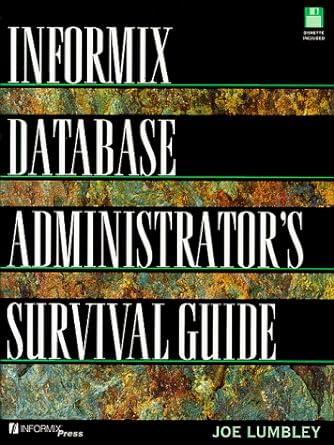Question
Use the following Case study to construct an entity relationship model. Define your entities, label your relationships, determine the cardinalities, and list the attributes. Be
Use the following Case study to construct an entity relationship model. Define your entities, label your relationships, determine the cardinalities, and list the attributes. Be sure to indicate your identifiers and list any assumptions you make.
The Urban Housing Agency (UHA) is a nonprofit organization that advocates the development and improvement of low-income housing. UHA operates in a metropolitan area of approximately 1 million people in a mid-western city.
UHA maintains data about the location, availability, and condition of low-income housing in nine different census tracts in the metropolitan area. Within the boundaries of these tracts are approximately 75 different properties that provide low-income housing. On average, each building contains 40 apartments or other units.
UHA keeps data about each census tract including geographic boundaries, population, the elected representative of the district, the two largest employers, several principal investors involved in properties in that tract, and other demographic and economic data. It also maintains a limited amount of data about crime rates.
For each building, UHA stores the building name, building address, building size (#of units), owner(s)s name and address, and mortgager(s)s name and address. They also track major renovations and repairs and who performed the work. UHA only manages buildings that are ADA compliant and they need to track the level of compliance including type of handicap access. In addition, UHA keeps a list of each of the units within each building. This list includes the type of unit, size, number of bedrooms, number of baths, kitchen and dining facilities, location in the building, and any special remarks. UHA would like to maintain typical demographic information on the occupants, income, #children, and if they are receiving other low-income assistance. This information will help with statistical and demographic reporting and analytics. Of particular importance is average occupancy rates and occupancy history for each unit. The agency has been unable to collect or store such data to date. UHA does, however, keep data about whether a given unit is occupied.
UHA serves an information clearinghouse and provides three basic services. First, it works with politicians, lobbyists, and advocacy groups to foster the development of legislation that encourages the development of low-income housing through tax incentives, developmental zoning preferences, and other legislative inducements. To accomplish this, UHA provides information about low-income housing to state, county, and city governments. Second, UHA strives to raise community consciousness about the need for low-income housing through electronic networks, advocacy speeches, seminars, displays at conventions, and other public relations activities. Finally, UHA provides information about the availability of low-income housing to other agencies that work with the low-income and homeless populations.
UHA wishes to consolidate this information into an agency database application. You are to do the design work. Develop a conceptual data model for this case using the entity-relationship methodology shown in class. Consider the mission of the agency and what they are trying to accomplish. Make sure you use good form, label your relationships, include essential attributes, determine all cardinalities and indicate your identifiers.
Step by Step Solution
There are 3 Steps involved in it
Step: 1

Get Instant Access to Expert-Tailored Solutions
See step-by-step solutions with expert insights and AI powered tools for academic success
Step: 2

Step: 3

Ace Your Homework with AI
Get the answers you need in no time with our AI-driven, step-by-step assistance
Get Started


